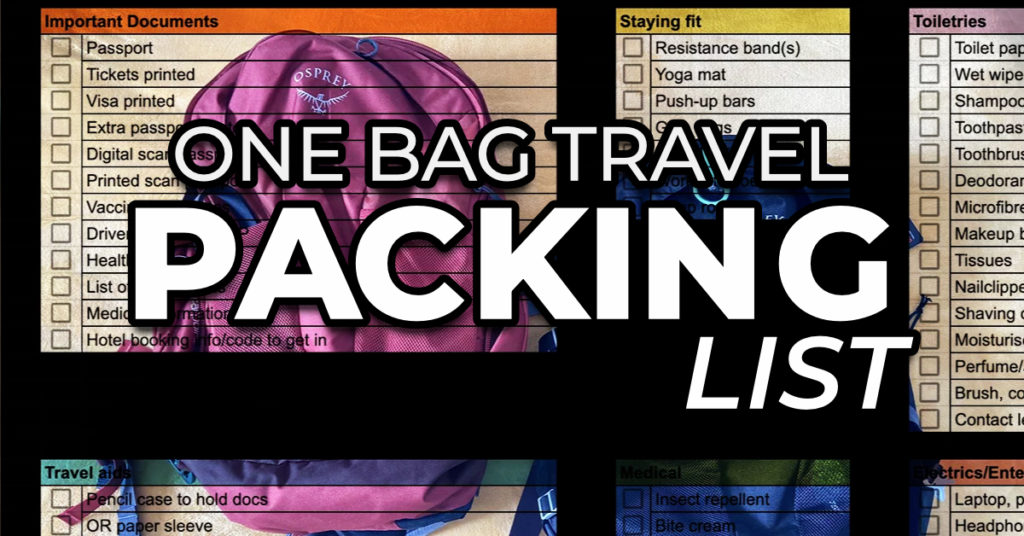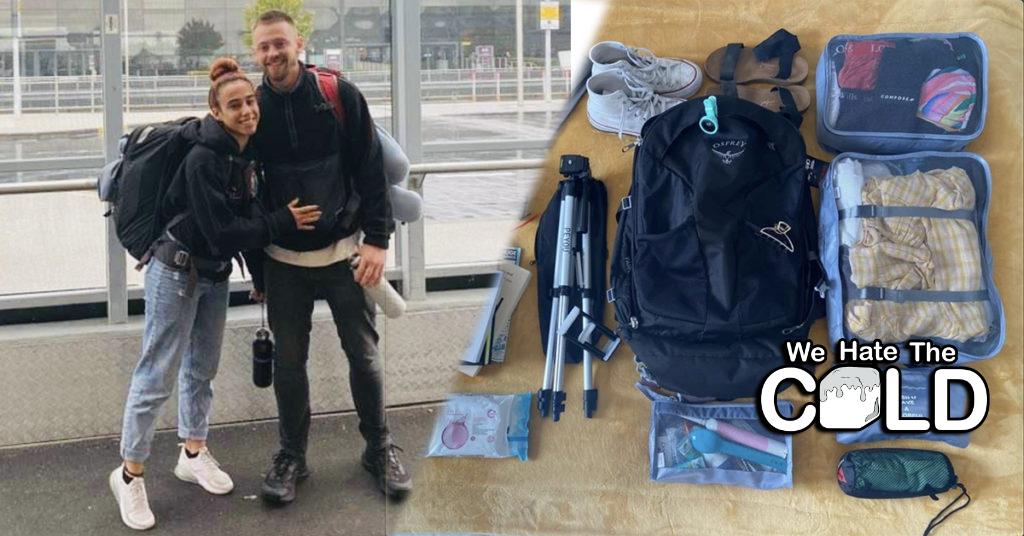Embarking on the iconic Inca Trail hike is a dream for many, but preparation is key to ensuring a smooth journey. Crafting the perfect packing list can make all the difference between a comfortable trek and a challenging ordeal. When doing the 4-day trail with my partner, there were many things we wish we had known before starting the hike. In this article, we’ll share exactly that, as well as a complete inca trail packing list for men & women, what we wish we knew before going, tips to optimize your packing, and more.
Quick Inca Trail Packing List for The Hike To Machu Picchu
The Ultimate Woman’s Packing List for the Inca Trail
- 4 shirts long sleeve or short sleeve
- 1 thermal shirt long sleeve
- 2 jogger pants or leggings
- 1 pair of sweatpants
- 1 pair of shorts
- 1 sweatshirt
- 2 jackets (one lighter and one heavier)
- 1 pair of flip flops
- 1 pair of hiking shoes
- 5 pairs of socks
- 5 pieces of underwear
- 2 comfortable bras (for women)
- 1 pair of thermal socks
- 1 pair gloves
- 1 warm hat or beanie
- 1 scarf
- 1 hat for the sun
The Ultimate Men’s Clothes Packing List for the Inca Trail
- 4 shirts long sleeve or short sleeve
- 1 thermal shirt long sleeve
- 2 jogger pants
- 1 pair of sweatpants
- 1 pair of shorts
- 1 sweatshirt
- 2 jackets (one lighter and one heavier)
- 1 pair of flip flops
- 1 pair of hiking shoes
- 5 pairs of socks
- 5 pieces of underwear
- 1 pair of thermal socks
- 1 pair gloves
- 1 warm hat or beanie
- 1 scarf
- 1 hat for the sun
Important Documents
- Passport
- Health Insurance
Toiletries
- Toilet paper
- Wet wipes
- Shampoo & conditioner bars
- Toothpaste
- Toothbrush, floss, mouthwash
- Deodorant (roll on 50ml lasts forver)
- Microfibre towel (travel towel)
- Tissues
- Moisturiser, creams
- Brush, comb
- Contact lenses
- Body soap
- Sunscreen
Medical
- Basic first aid items
- Insect repellent
- Bite cream
- Ibuprofen
- Blister plasters
- Your medications
- Hand sanitiser
- Plasters
- Cut disinfectant
- Throat sweets
- Compression socks for ankle support
Travel Aids
- Smaller pouch bag/fanny pack
Electrics/Entertainment
- Flashlight
- Portable phone charger
- Small book
Finances
- Foreign currency
- Home currency
- Debit and credit cards
- Emergency money
Misc
- Water bottle
- Cereal + protein bars
- Trekking poles
A Day-By-Day Breakdown of the Inca Trail
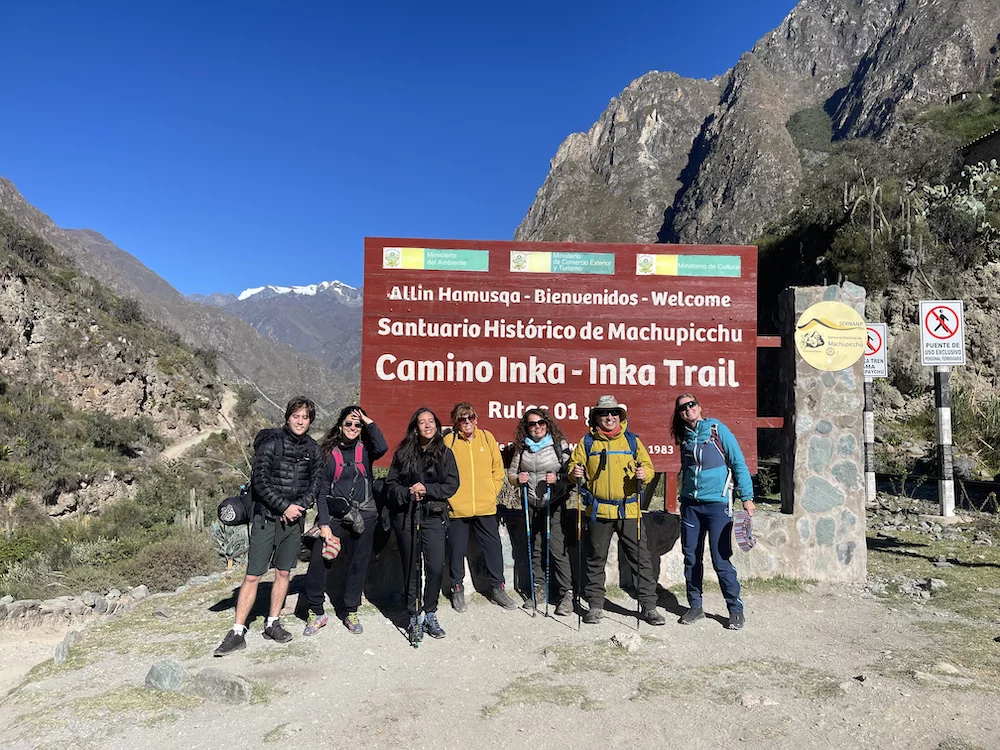
The Inca Trail (sometimes called the trail to Machu Picchu) is soaked in historical significance, cultural depth, and stunning vistas. It spans roughly 26 miles (42 kilometers) and is typically covered over a span of four days, with each day having its unique set of marvels and challenges.
Here’s a rundown of the trail to offer a better perspective of the adventure ahead:
Day 1
The trail starts rather easily, regarded by many as a ‘warm-up’ to the forthcoming trek. The journey of about 7.8 miles (12.5 kilometers) starts at Kilometer 82. Initially, trekkers walk on fairly level grounds, tracing the edges of the Urubamba River. As the journey unfolds, an ascent into agricultural lands offers the first view of an Inca relic, the Llactapata ruins. The day draws to a close at Wayllabamba, allowing trekkers to rest amidst the Andean background.
During the first day, I realized I did a good job packing a small bag. Even on level grounds, we still walked a lot, and any extra weight would have been annoying to carry around. Make sure your bag is comfortable around the shoulders, as mine were a little sore by the end of the day. Snacks were really necessary as well, as it takes around 5-7 hours from lunch to dinner time. When the sun set, it got really cold, and I used all of the layers I had brought for the night. We used the sleeping bag pouches as pillows, stuffing our clothes inside.
Day 2
Day two is, without doubt, the most demanding segment along the trail. Although it’s about 5.9 miles (9.5 kilometers), the route involves a daunting climb to the peak of the trail, known as Dead Woman’s Pass or Warmiwañusca in Quechua, which towers at 13,828 feet (4,215 meters). For those who have tourbled knees, a hiking pole can really come in handy here, and at times I wish I had asked for one before starting the trail. However, even without it, I managed to be one of the first people to get to the top.
The ascent transitions from a cloud forest to the puna, a high-altitude terrain distinguished by grasslands and unique flora. Upon reaching the peak, hikers are rewarded with unparalleled achievement and sweeping views of the valleys below.
Layering also proved itself to be effective this day, as temperatures would change a lot.
Day 3
On this day, even though the distance is roughly 10 miles (16 kilometers), the path is marked by historical gems and mostly downhill treks. Descending from the second pass introduces trekkers to the Runkurakay ruins, a historic Inca resting place. Further down, you’ll witness the Inca landmarks of Sayacmarca and Phuyupatamarca, both boasting mesmerizing outlooks. Because of the fast-paced descents, my boyfriend got really bad blisters on his feet, and we had to borrow band-aids from some other trekkers.
The journey for the day ends at the Wiñay Wayna camp, positioned near the ruins bearing the same name.
Day 4
The concluding day, though the shortest at around 3.2 miles (5 kilometers), is the pinnacle of the entire journey. Eager hikers often set off at dawn to be at Inti Punku, or the Sun Gate, as the sun rises. We had to wait for about an hour until the gates opened, and it was pretty cold outside. Gloves, a beanie and a scarf really kept me warm here, and I’m glad I packed them.
This location offers the inaugural sight of Machu Picchu, shining in the golden morning light. A mild descent leads to the ruins of Machu Picchu. After indulging in the site’s history and views, most opt to head to Aguas Calientes, marking the end of their Inca Trail experience.
Packing for Different Seasons on the Inca Trail
The Inca Trail showcases the breathtaking landscapes of the Andes, but its altitude and diverse ecosystems mean weather can vary dramatically. The best time of the year to hike the trail is during the dry season when temperatures are lower, and there are no rain chances. The trail is usually closed during the summer because of maintenance and heavy rainfall.
Your packing list for the Inca Trail might differ depending on when you choose to trek. Here’s a breakdown by season:
Dry Season (May to September):
For dry season, you need to pack lightweight hiking pants, moisture-wicking shirts, and a fleece jacket for colder evenings. You pretty much need to follow the packing list above, which is what I took when I went to the trail at this time of the year. Waterproof hiking boots are always recommended, but paths will generally be drier. Even with the lower temperatures, the sun is still pretty strong, so bring a sun hat, sunglasses, and sunscreen to protect against the strong mountain sun.
Since temperatures tend to change abruptly, it is smart to dress in layers, taking them off one by one as the sun rises.
Shoulder Season (April and October):
These months usually have some rainy days, so preparing for that is important. Pack an extra layer, as temperatures can be unpredictable. A waterproof rain jacket and windproof outer layer is crucial. Waterproof hiking boots with good grip for potential wet paths can help you avoid accidents, and lightweight gloves and a beanie could be beneficial during colder mornings and evenings.
General Essentials for All Seasons:
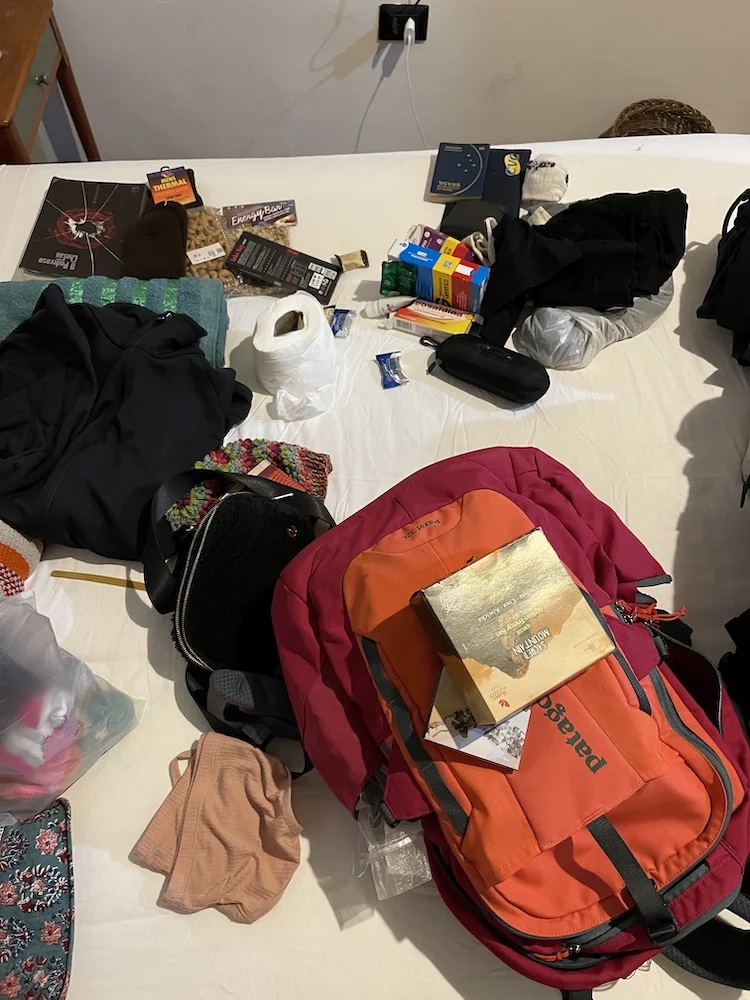
- A sturdy backpack with good support.
- Waterbottle
- First aid kit, including blister treatments.
- High-calorie snacks and energy bars.
- Personal identification and necessary permits.
- Pretty much everything in the packing list above.
Clothing Etiquette on the Inca Trail
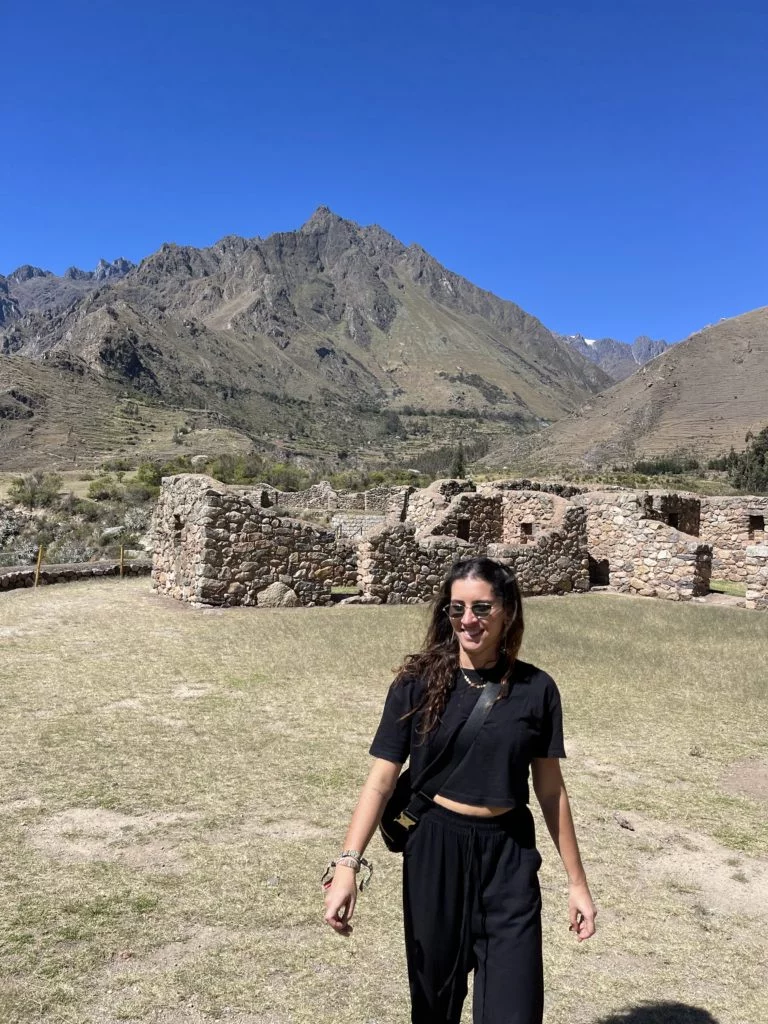
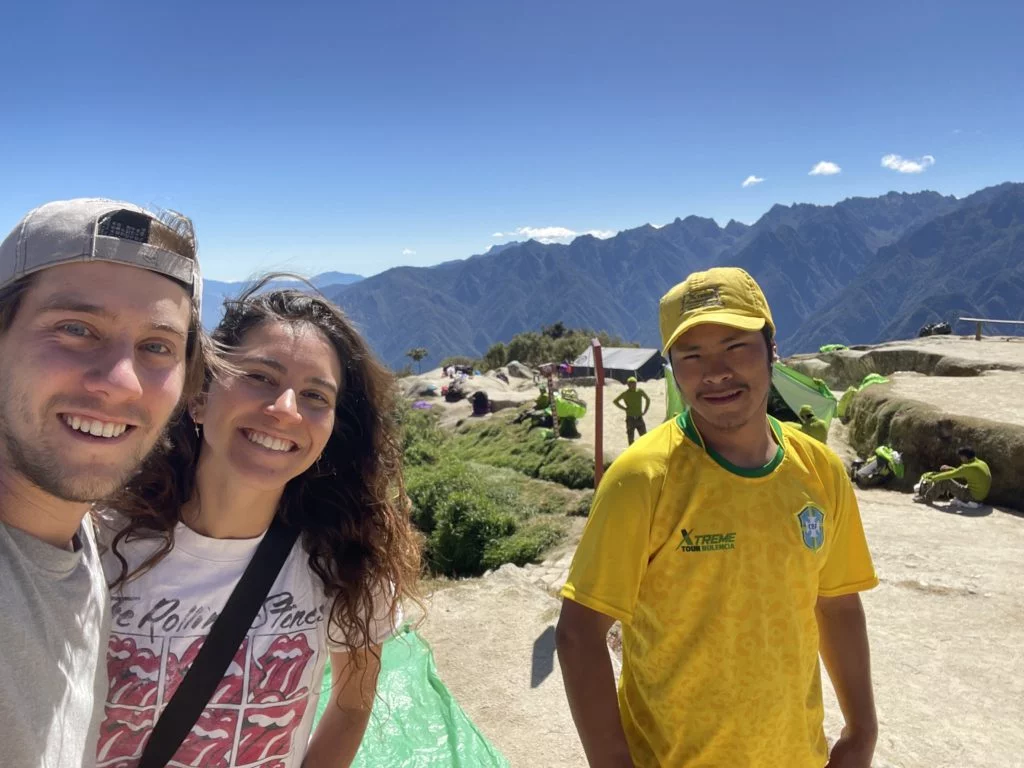
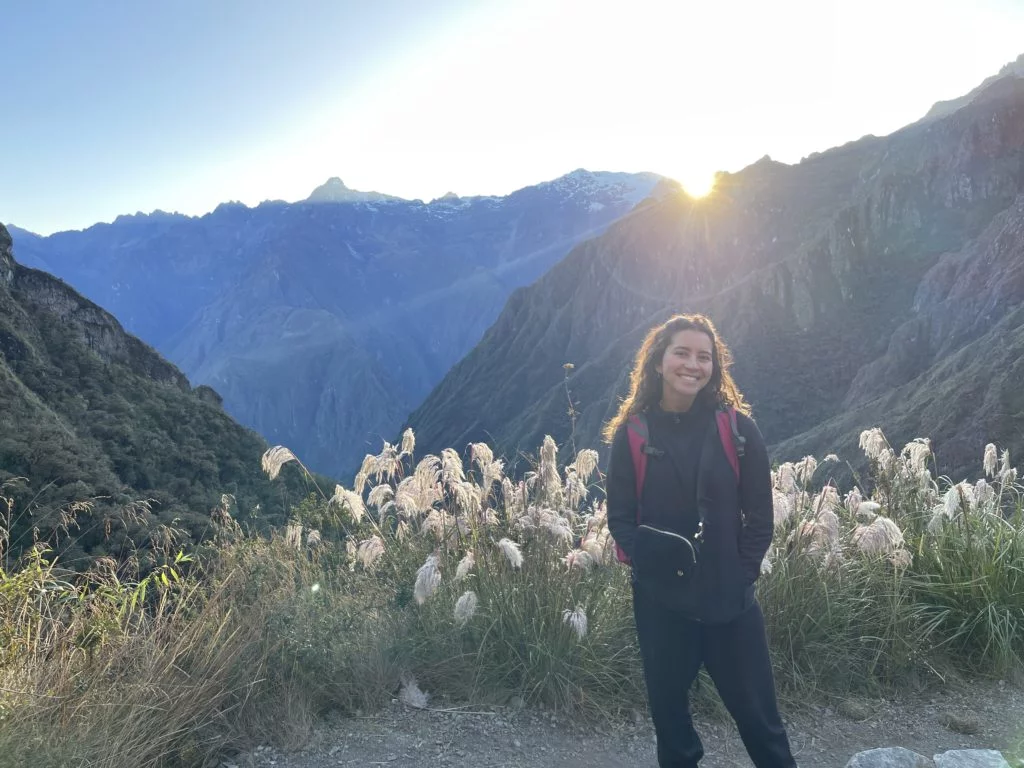
There is no clothing etiquette specifically for the Inca trail, it is best to wear comfortable and weather-appropriate clothing. However, at some points during the trail, you will pass significant sacred sights and local villages where locals will often be covered. For these moments, it’s most respectful to wear loose respectful clothing.
You will not be told off if you do otherwise, but it is good to follow local customs regarding clothing. It will also allow you to make more connections during your expedition on the Inca trail.
The Inca Trail isn’t just a scenic trek; it’s a journey through the Andean culture and history. While the primary concern for most trekkers is to wear comfortable and weather-appropriate clothing, it’s also worth considering a few clothing etiquette points to show respect and awareness:
Modesty
Although the Inca Trail is primarily a tourist route, you may encounter local communities or sacred sites. It’s advisable to dress modestly, particularly when passing through or visiting these areas. Avoid wearing overly revealing clothing. My daily clothing comprised loose trekking pants and a graphic shirt, covered with warm jackets and a scarf, for example.
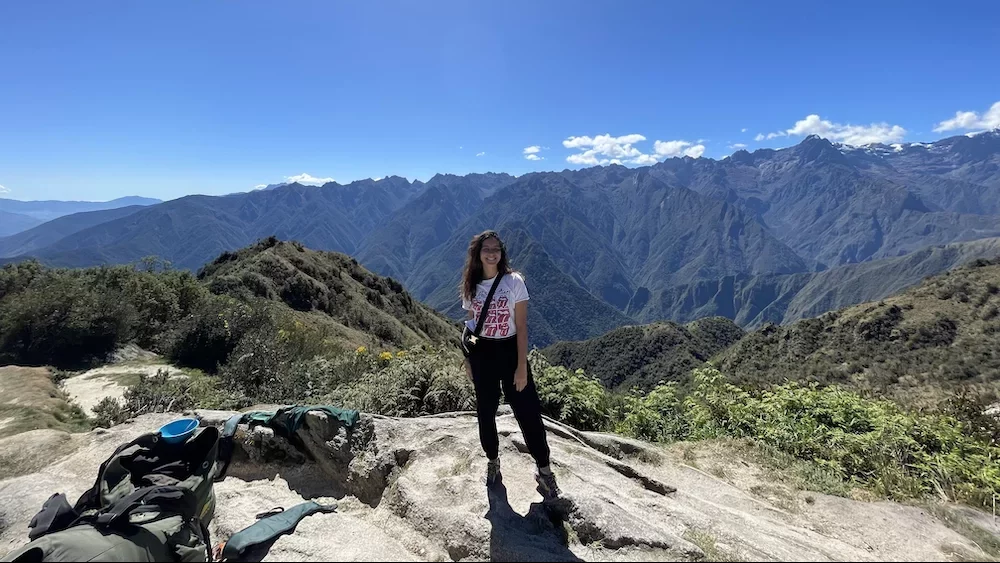
Respect Sacred Sites
On reaching Machu Picchu or other sacred ruins, being mindful of your attire is essential. While there’s no strict dress code, wearing respectful clothing — similar to what you’d wear when visiting any sacred site around the world — is a good rule of thumb.
Environmentally-Conscious Choices
Environmentally-conscious clothes are garments produced using sustainable materials and methods that minimize negative environmental impacts. While this isn’t strictly “etiquette,” opting for environmentally-friendly clothing can make a difference to the world. Consider bringing items made from sustainable materials like organic cotton, hemp, wool, and tencel/lyocell, and avoid items that can easily shed microplastics.
Most of my clothes were made out of cotton, which was perfect because they were light and breathable, not holding up sweat or any unpleasant odors during the trail.
Important note: you won’t find many trashcans on the trail, and tossing things in the trek is a big no-no. We actually carried our trash with us until we found places where we could dispose of them, which didn’t happen very frequently. Because of that, avoid bringing a lot of plastic wraps and other things that need to be thrown away.
Local Crafts
Wearing or using items crafted by local artisans, such as hats, scarves, or bags, can be a wonderful way to support the local economy. Just ensure you’re purchasing genuine handcrafted goods rather than mass-produced items.
Brands and Logos
Flashy logos or overly branded gear isn’t necessarily offensive but can create a barrier between trekkers and locals. Opting for more neutral, unbranded attire can foster a sense of approachability.
Money on the Inca Trail: Essential Tips for Trekkers
Pack Beforehand or Exchange There?
When exchanging money for the Inca trail and in Peru in general, if you travel with USD or any other currency, do not exchange it at the airport, as the fees will usually be higher than exchange places in the city. Wait to arrive at Cusco’s city center (you will probably fly into Cusco for the Inca Trail), and you will find plenty of places that work with friendlier rates.
Peru, home to the Inca Trail, uses the Peruvian Sol (PEN) as its official currency. While many travelers opt to carry a certain amount of local currency before arriving, several options are available for currency exchange and withdrawal in the country.
These options are:
- Exchange houses – spread across every town, and they all have similar and fair rates. You can exchange your dollars here.
- ATM – you can withdraw Peruvian Sols straight from your bank account at ATM machines. However, there is a withdrawal fee between $5-10, this is from your bank back home, not the ATM. Revolut, Starling Bank, Chase, Wise an others offer free withdrawals abroad.
- Pay by card – debit and credit cards make the conversion automatically once you use them. Although the rates might be a little off, it is still okay to do so if you’re running out of money or want to save it for the artisanal markets and other things.
Can you withdraw cash?
ATMs are widely available in major cities like Cusco and Aguas Calientes. They usually dispense both PEN and USD. Given the fees, you can use Western Union services in Peru, but it’s more commonly used for emergencies.
What are the fees?
ATM fees can vary, but expect a local bank charge of 5-20 PEN per withdrawal.
Foreign exchange fees
Most foreign cards charge a foreign transaction fee, usually 1-3% of the purchase amount. It’s best to check with your bank beforehand.
Can I use foreign cards?
Major cities and tourist areas generally accept foreign credit and debit cards, particularly Visa and MasterCard. However, smaller establishments or remote areas may not have this facility. Always have some cash on hand. When in the Inca Trail, you will not be able to use credit or debit cards, as the establishments are very humble. You need to bring cash with you before you start the walk!
Do they take USD as payment?
Not in the Inca Trail. In near towns like Aguas Calientes, you may find some establishments that accept USD, but don’t expect the same once you’re into the Andean jungle.
Best place to exchange currency
Avoid exchanging money at the airport, as rates are typically unfavorable. Instead, look for “Casa de Cambio” (exchange houses) in cities like Cusco and Aguas Calientes. They offer competitive rates. Just ensure they’re reputable.
ATM or Exchange?
While ATMs are convenient, frequent withdrawals can rack up fees. Using exchange houses can be more economical for larger amounts. Still, the best approach is a mix of both, depending on the situation.
Scams
Beware of counterfeit bills. When receiving change, inspect the notes for authenticity. Also, be cautious of unofficial street currency exchangers offering “too-good-to-be-true” rates.
How Much Money Do I Need For The Inca Trail? | How Much We Spent
To hike the Inca trail, you will need to take:
- Doable – 220 PEN ($60)
- Comfortable – 350 PEN ($90)
- Buy whatever you want – 500 PEN($130)
My partner and I hiked the Inca trail – below is a full breakdown of what we spent. We took 460 PEN ($120). This was sufficient for tipping the porters and our guide. We didn’t buy any snacks or souvenirs on the trail (since we had brought a lot of protein bars and chocolate packed already). However, we both agreed we wished we had taken a little more, for souvenirs once we arrived at Machu Picchu. The amount we took was enough to endure the trail comfortably, so if you’re on a budget, to hike the Inca trail, $60 for 1 person is absolutely fine.
Below we’ve also left the average Peruvian Sol we personally used while hiking the Inca trail:
- 40 PEN ($10.54) total on breakfast during the first day before arriving on the trail.
- 20 PEN ($5.27) on Gatorade during the second day, which we bought from local ladies with stands filled with snacks and drinks.
- 180 PEN ($47.42) for tipping our guide and the porters at the end
- 40 PEN ($10.54) on snacks and coffee once we got to Machu Picchu.
What’s Included in the Inca Trail Price?
There are many things that are included in the price you pay to do the trail:
- All three meals during the first 3 days, and breakfast on the last day.
- Water (the porters carry water gallons that you can use to fill up your own water bottle).
- The entrance to the park
- The entrance to Machu Picchu
- The bus ticket back to Aguas Calientes
- The train ticket back to Ollantaytambo.
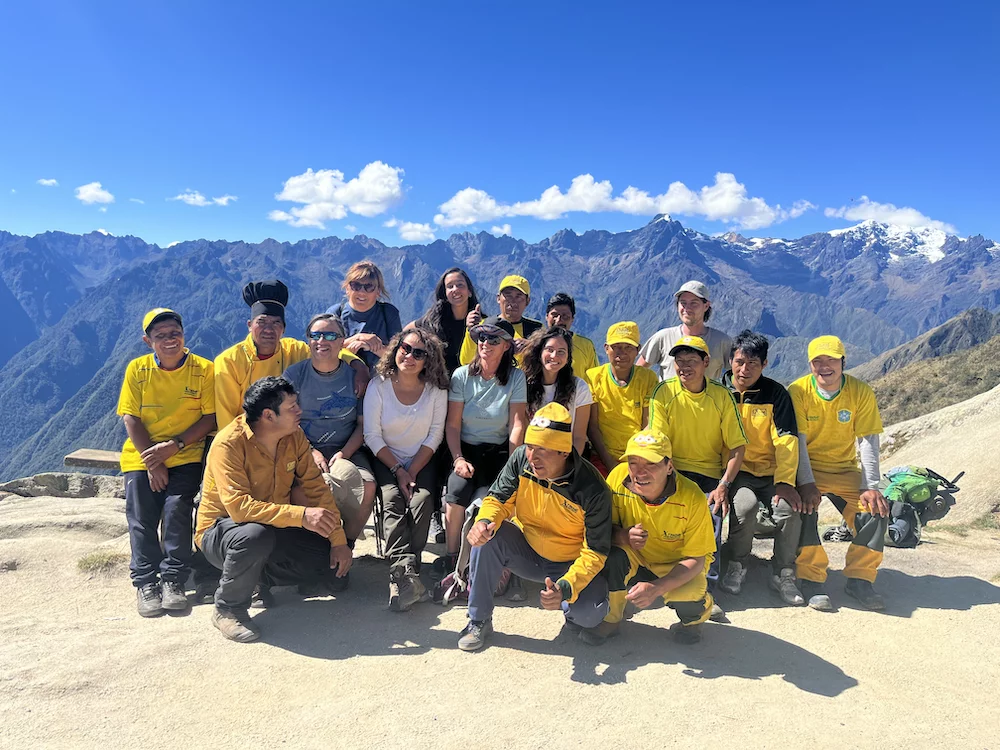
How to Backpack to the Inka Trail? That is The Question
When referring to the Inca Trail, you should DEFINITELY backpack, there is no option to bring a suitcase. However, if you plan on staying in Peru for longer, you can always bring a suitcase with your backpack inside and then leave it at your hostel before the trail, returning to it in the end. This allows you to pack more things you would need during the other days of your trip, but that might be unnecessary weight during the trek. Leave these items with your suitcase, and you can have the best of both worlds.
This is personally what I did, and it helped with bringing more outfits and fancier clothes to my larger Peru trip. However, if you’re only going for the Inca trail, I would suggest bringing only a backpack, and maybe leaving some unnecessary items inside a smaller back at your Cusco hotel/hostel before leaving for the trail.
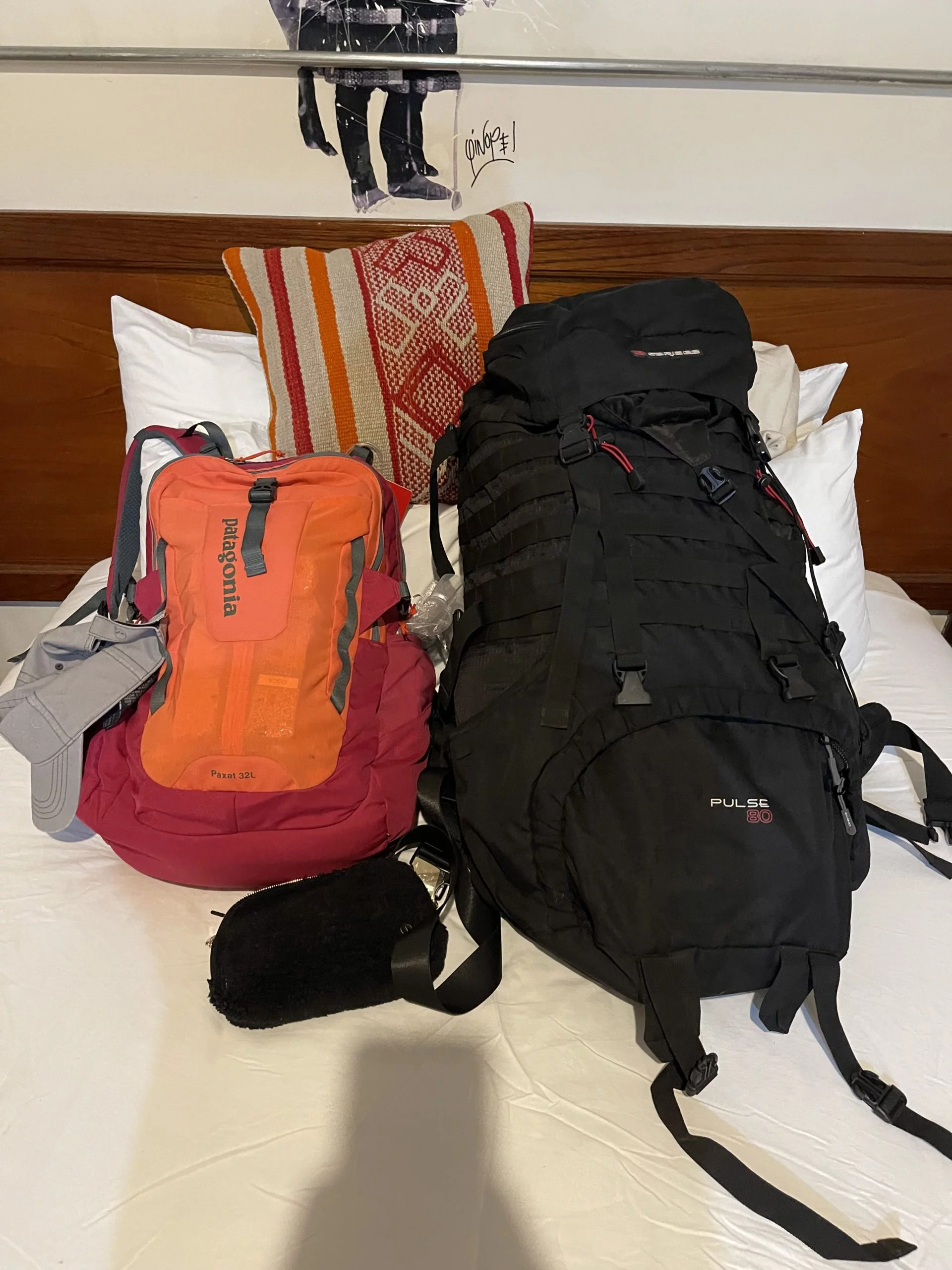
What Style Bag Should I Take?
When it comes to the Inca Trail, the lighter and smaller the better. You will be walking for hours on end, on ascents and descents, so your bag cannot be something that slows you down. Mine was the 32L Patagonia Paxat day pack, which was more than enough to fit everything inside. You can bring a bigger duffel bag if that’s all you have, but pack lightly.
My bag had breathable straps and really good back and chest support. However, it lacked waist belt support, which would have been helpful. No matter the bag you take, your shoulders will be hurting by the last days of the trail, but you can minimize that with straps and other supporting mechanisms. Also, make sure to bring a bag with different pockets and sections, just to make the packing and unpacking easier when reaching the campsite.
Packing Tips To Optimise for Space & Weight | How To Fit More in Your Bag
Best Practices for Packing
Packing is easy; packing well is an art. When walking all day long and having to take almost everything off your back to reach for one essential item, some tips can come in handy:
Roll, Don’t Fold
Rolling your clothes can save space and often results in fewer creases compared to folding. Lay clothes flat, smooth out wrinkles, and then roll tightly. One pro tip is to use the clothes inside your backpack as a pillow. At night, we filled the sleeping bag case with our clothes and slept on top of it, which highly improved our comfort.
You don’t need vacuum or compression bags; it will just be extra work when it’s time to pack and unpack when it’s cold and dark outside.
Layering
Pack lighter items, like clothes, at the bottom and layer heavier ones, like your toiletry bag, on top. This way, the heavy items ‘squeeze’ the lighter ones, allowing for more space in your bag.
Utilize Dead Space
Stuff socks or other small items into your shoes or other nooks and crannies.
Mind the Importance of Things
Items that you use more regularly should go in compartments that are more accessible. Keep your snacks, sunscreen, hat, and anything you might need to use during the day at the top of the bag or at separate pockets. This way, you won’t need to unpack the whole thing to reach for a single item.
I would also suggest taking a shoulder bag specifically for these items, so you don’t have to take your bag off your shoulders and unpack every time you need something. The little things like this make all the difference when you’re hiking for 4 days!
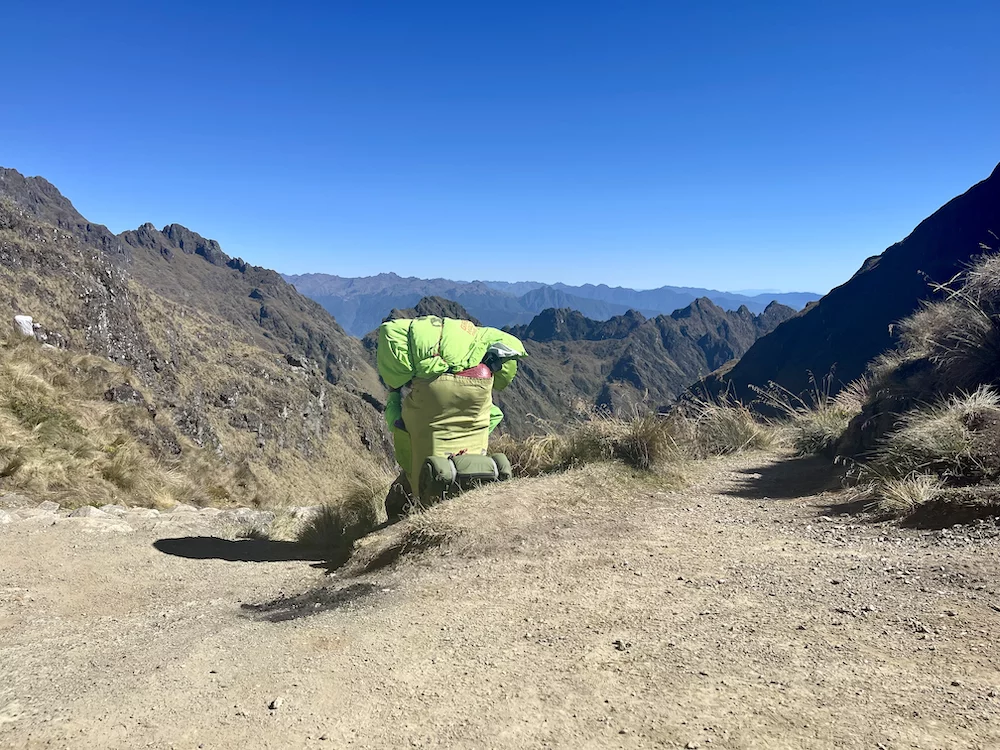
What We Wish We Didn’t Pack:
While the Inca Trail can be chilly, many travelers overcompensate. Light, moisture-wicking layers are more efficient than bulky sweaters, as these will have to go inside your backpack when the sun comes out during the day, making it heavier and less practical. Also, you will not change as much as you think you will, so don’t get excited with pants and shirts.
Personally, I wish I hadn’t taken some of the clothes I brought, because I didn’t end up using them and it was just extra weight on my back. Also, I would recommend minimizing the amount of entertainment you bring – one single small book and a deck of cards is enough. I also packed some makeup, thinking I would use it, but it was the last thing I wanted to put on my face.
What We Wish Someone Told Us To Take Before Packing for the Inca Trail:
We definitely wish we had brought more money than we did, since at the end, everybody gets together to tip the men who carry the tents and food for us; although we tipped the same as everyone else (the recommended minimum amount of 80 PEN per porter and 100 PEN for the guide), we wish we would have given them more). Also, most small vendors on or near the trail do not take cards. Having a stash of Peruvian Sol would have been handy. Taking some meds for sore muscles and blisters is important, as we cover an average of 10km per day. My boyfriend had bad blisters on the last day, and we had to borrow band-aids and painkillers from some of our fellow trekkers.
Emergency Details To Sort Before Going
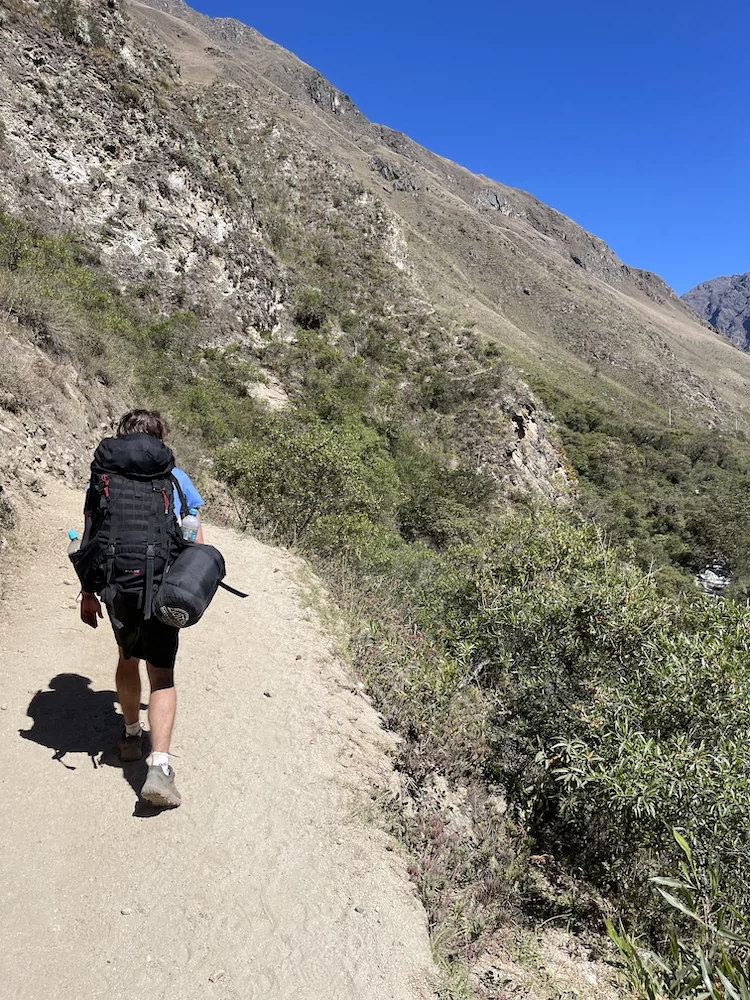
Whether embarking on an adventure like the Inca Trail or just a standard trip, preparing for emergencies is essential. Here’s a checklist to ensure you’ve got everything sorted:
Emergency Contacts
Compile a list of essential contacts, including family, close friends, your country’s embassy in the destination country, local emergency services, and your travel insurance’s helpline. Ensure these numbers are saved in your phone and in a physical form in case your battery dies.
Medical Information
If you have any medical conditions, wear a medical ID bracelet. Keep a card listing allergies, medications, and other pertinent health info in your wallet. Carry a basic first-aid kit and any specific medications you may need.
Travel Insurance
Ensure you have comprehensive travel insurance covering activities you’ll participate in. Understand your policy: know what is covered and what is not. Save a digital and physical copy of your insurance policy.
Backup Documents
Make copies (both digital and physical) of crucial documents: passport, visas, driver’s license, itinerary, hotel reservations, and travel insurance. Store digital copies in a secure cloud storage or on a USB, and physical copies separate from the originals.
Emergency Funds
Always have some local currency in cash for unforeseen emergencies. Consider carrying a separate emergency credit card or prepaid card.
Notify Someone of Your Itinerary:
Always let someone know where you’re going, your routes, and expected check-in times. This could be a family member, a close friend, or even an online travel group.
In essence, while no one anticipates emergencies, being prepared can make a difference in how you handle them. Taking the time to sort these details can grant peace of mind, allowing you to enjoy your journey more fully.
FAQ – Frequently Asked Questions
What do you need to pack for the Inca Trail?
Essential items include a backpack, hiking boots, lightweight and moisture-wicking clothing, rain gear, sun protection (hat, sunglasses, sunscreen), first-aid kit, reusable water bottle with built-in filter, personal medications, flashlight, sleeping bag, and some snacks. Pack essentials based on seasonality, personal needs, and advice from your tour company.
Can you eat coca leaves on the Inca Trail?
Coca leaves are permitted on the trail and many tourists chew these leaves to combat the altitude and provide more engergy. They help to reduce tiredness and hunger and this is the reason many locals will chew coca leaf, to work long hours and withstand harsh conditions. We personally didn’t purchase any on the inca trail, but they are available at the shops. You can also purchase coca sweets and red/white pills which will help with altitude sickness as you go further.
Are Tents, Sleeping Bags & Mats Provided on The Inca Trail?
Tents are provided on the trail, you will also get a thin sleeping mat, and if you haven’t got a sleeping bag one can be rented for about $14. They do weigh a lot and are bulky though, so it’s best to bring your own. An optional upgrade to an airbed is also available at $14 for the hike, however, they also weigh a fair bit. It’s best to travel light so we recommend bringing your own sleeping bag and using the thin mat.
How much weight does the porter carry on the Inca Trail?
Porter’s carry a maximum of 20kg (men), and 15kg (women) with an allowance of 5kg for personal items. You are able to give your porter 6kg of items to carry for you throughout the 4-day hike. They are paid well, but it is extremely hard work, so if you have some money left, please tip the porters.
How much does a pack weigh for the Inca Trail?
The weight of your pack largely depends on the duration of your trek and personal packing habits. Generally, aim for a total pack weight of 20-25 pounds (9-11 kg). Remember, porters usually have a weight limit (around 20 pounds or 9 kg) for the items they carry for you.
How do I prepare for the Inca Trail?
Begin training several months in advance with a mix of cardiovascular exercises (like running and cycling) and strength training. Incorporate hiking with a loaded backpack to simulate trail conditions. Acclimatize in Cusco or another high-altitude area before starting the trail.
Am I fit enough for the Inca Trail?
If you can comfortably hike for 6-8 hours a day over hilly terrain, you’re likely fit enough. Always consult with a doctor before undertaking strenuous activities, especially if you have medical concerns.
What is the hardest part of the Inca Trail?
The ascent to Dead Woman’s Pass (Warmiwañusca) on the second day is often considered the toughest due to its steep incline and high altitude at 4,215 meters (13,829 feet).
What do you tip porters on the Inca Trail?
Tipping can vary, but a general guideline is $10-15 per day for guides and $5-7 per day for porters. It’s a gesture of appreciation for their hard work.
Do you shower on the Inca Trail?
There are very limited shower facilities, often cold, on the Inca Trail. Many trekkers use wet wipes or biodegradable soap for a basic wash.
Can you go to the toilet on the Inca Trail?
There are basic toilet facilities at the campsites. During the day, options might be limited, so it’s advisable to bring biodegradable toilet paper and hand sanitizer. Always follow Leave No Trace principles.
Camila is a true adventurer, with a love for hiking, exploration, and also the finer, more luxurious things in life. A tacos al pastor enthusiast, and lover of well-thought-out lodgings, hotels, and the Mediterranean Ocean, she has a passion for exploring the uncovered nooks and crannies of this beautiful blue earth – armed with her orange carry-on backpack. You’ll find Camila writing in detail about all things South America here on WHTC. Anything you need to know from hiking the Inca trail to digital nomad-ing around Latin America to uncovering the great, unknown spots in Brazil (and more) – Camila is here to help carve the path and make traveling easier for all.

